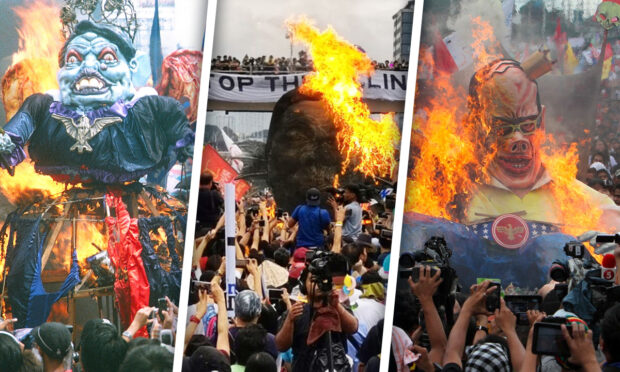Artist defends burning of ‘Doble Kara’ effigy during Sona: Freedom of expression

COMPOSITE IMAGE: Protesters burn effigies of Gloria Macapagal-Arroyo, Rodrigo Duterte, and Benigno Aquino III during rallies timed for Sona deliveries of the then presidents in 2007, 2005 and 2019. WIKIMEDIA COMMONS, KARAPATAN, INQUIRER FILE PHOTOS/RAFFY LERMA
MANILA, Philippines — The “Doble Kara” effigy of President Ferdinand “Bongbong” Marcos Jr. “must be viewed as an expressive conduct protected by the freedom of speech and expression guaranteed under the Constitution,” artist and social activist Max Santiago said on Tuesday before the Quezon City Prosecutors Office.
Santiago is facing a complaint for violating the Clean Air Act (Republic Act 8749) and the Ecological Solid Waste Management Act (RA 9003) after they burned the huge effigy.
The Quezon City Police District, the complainant said that the burning of the effigy during the State of the Nation Address (Sona) of Marcos “greatly contributed to air pollution which grossly negates the government program in ensuring the protection of public health and the environment.”
READ: QCPD goes after artist behind Marcos effigy burned at Sona
Santiago submitted his counter-affidavit on Tuesday, responding to the complaints filed by the police.
Article continues after this advertisementIn his counter-affidavit, Santiago, through his counsel, pointed out that under the Solid Waste Management Act, solid waste refers to “various forms of discarded materials, including household waste, commercial waste, non-hazardous institutional and industrial waste, among others.”
Article continues after this advertisementThey added that even under the Clean Air Act, the effigy is not considered “waste.”
They pointed out that the effigy does not fit into the categories of “municipal waste,” “biomedical waste,” or “hazardous waste,” as outlined in the Clean Air Act and its implementing rules.
“The act categorizes these waste types separately from general waste, and the defense firmly maintains that none of these classifications accurately apply to the effigy,” they said, adding that the “Doble Kara” effigy is a meticulously crafted piece of art which is distinct from waste material.
Santiago’s counter-affidavit also raises the jurisdictional issue as the police officers failed to specify the location where the offenses were allegedly committed.
“This lack of clarity regarding the locus criminis, or the place where the crimes occurred, creates uncertainty about the jurisdiction of the prosecuting office over the charges,” read the affidavit.